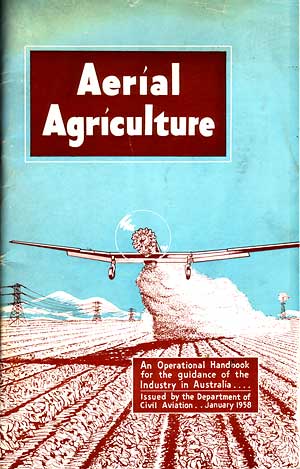
Concerns
about the safety of the aerial agriculture industry in the early post-Second World
War years led, among other things, in January 1958 to DCA
issuing Publication 34 Aerial Agriculture, sub-titled An Operational
Handbook for the Guidance of the Industry in Australia.
The contents of this handbook included:
- Pilot Training
- Base Air Strips
- Calcluations to Assist the Operator
- Distribution of Solids
- Spray and Dust Distrribution
- Aircraft Distribution Equipment
- Parathion and Systox Insecticides
- Sulphur Fire Prevention
- Flight Fatigue
- Accident Analysis and Prevention
- Chemical Classifications
- Medical Aspects
- Statistics
The foreword is reproduced below:
"In
recent years aerial agriculture in Australia has undergone rapid expansion. Organisations
both large and small have taken part in this developing industry in which, since
1954, operations have increased threefold. Such spectacular development has not
been achieved without cost. In aerial agriculture, where flying skill and safety
considerations are so very important, accidents have occurred. Some of them might
have been avoided had closer attention been given to basic safety measures.
Aerial agriculture operators, whether they be large or small organisations, must build customer relations at the level of their field representatives. Perhaps more than in any other industry sales promotion is a part of the duty of the man on the job; in other words, the aerial agriculture pilot. He can, by his knowledge of plant pathology and entomology and the correct use of herbicides and insecticides render invaluable assistance to the man on the land. A well-trained pilot backed by the knowledge available from State and Commonwealth Agriculture and Health Departments, can play an increasingly important part in the country's agricultural economy.
The aim of this booklet is to provide technical and practical information so that operators may stabilise the aerial agricultural industry by safe and orderly practice. Much of the basic information has been supplied by courtesy of the New Zealand and the United States Governments, and co-related to Australian conditions by an officer of the Department of Civil Aviation who has studied aerial agriculture both overseas and in Australia. Chapters on the medical aspects of insecticides, classification of agricultural compounds, and flight fatigue have been contributed by the Division of Aviation Medicine, Department of Civil Aviation.
If the information is conscientiously applied, the service the aerial agriculture operator has to offer should become safer and more efficient. Although much of the material is aimed at the pilot newly entering the aerial agricultural field, even the most experienced operator may find himself in a position where he has not had experience in certain phases of aerial agriculture. To this pilot this booklet can be a very valuable guide."
Click here to read a newspaper article on the use of DCA Tiger Moths to test prospective aerial agriculture pilots
Back
to the main DCA Publications index
Back to the main Industry Regulation & Aviation Policy index
Back to the main Air Safety and Accident Investigation index
If
this page appears without a menu bar at top and left, click
here